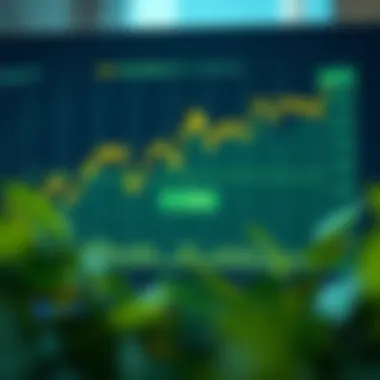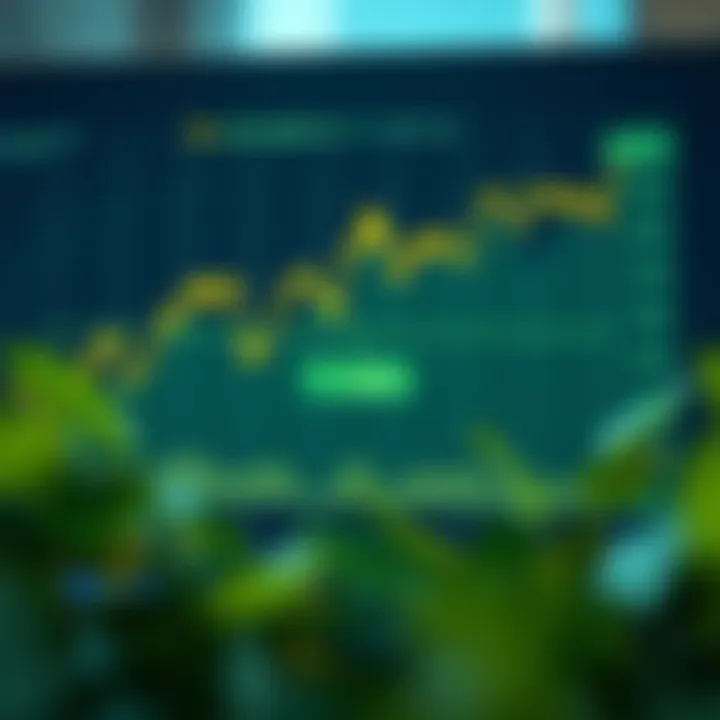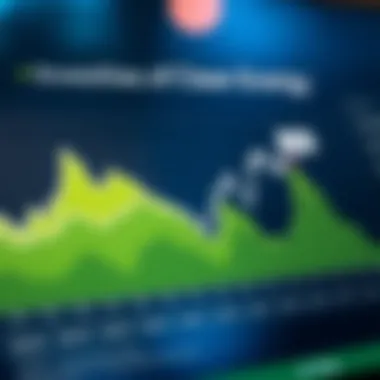Exploring iShares Global Clean Energy ETF Holdings


Intro
In the landscape of investing, clean energy has emerged as a beacon of hope for sustainability-minded investors. The iShares Global Clean Energy ETF provides a compelling opportunity for those looking to allocate their resources toward environmentally friendly companies. As the world pushes for greener energy solutions, understanding the components and strategy behind this ETF gives potential investors an edge in navigating today's green finance landscape.
The iShares Global Clean Energy ETF focuses on investing in companies worldwide related to the production, distribution, and use of clean energy. This might include businesses involved in solar power, wind energy, hydroelectric power, and energy efficiency technologies. Not only do these investments aim to yield financial returns, but they also contribute to achieving a cleaner, sustainable future—a dual goal that resonates with many.
Key Terms and Definitions
To understand the iShares Global Clean Energy ETF fully, it’s essential to familiarize ourselves with specific terms that frequently arise in discussions around ETFs and clean energy investments.
Investment Concepts
- Exchange-Traded Fund (ETF): A type of investment fund that trades on stock exchanges, similar to stocks. Investors buy shares of the ETF, which represents a basket of underlying assets.
- Clean Energy: This term encompasses energy generated from renewable, sustainable resources, such as sunlight, wind, and geothermal heat.
- Net Asset Value (NAV): This represents the total value of the ETF's assets minus its liabilities, crucial for understanding the price per share of the ETF.
Financial Instruments
- Stock: A share in the ownership of a company, allowing investors to benefit from its successes or risks.
- Bond: A fixed income instrument that represents a loan made by an investor to a borrower, typically used to fund various projects.
- Diversification: A risk management strategy that involves a wide range of investments to reduce the impact of any single asset’s poor performance.
Expert Advice
Navigating the clean energy market can be daunting, but with the right strategies, investors can optimize their approach.
Long-term vs. Short-term Investing
Investing in the iShares Global Clean Energy ETF can be viewed through different lenses. For seasoned investors, a long-term perspective may yield more fruitful results. Clean energy is often marked by volatility driven by regulations and technological advancement. Short-term investors might see rapid price changes but could risk missing out on the long-game advantages.
Risk Management Strategies
Investing in clean energy comes with its share of risks, these include:
- Market Volatility: Prices may fluctuate significantly based on global energy demands, regulatory changes, and technological breakthroughs.
- Sector-Specific Risks: Clean energy investments may face scrutiny regarding their long-term viability compared to traditional energy sectors.
To manage these risks, investors might consider diversifying their portfolios, utilizing stop-loss orders, and maintaining an informed stance on market trends.
Investing in clean energy not only aids in personal wealth creation but also facilitates broader environmental goals. This dual benefit makes it a unique avenue in today's financial arena.
By understanding the underlying terms and strategies, investors can navigate the complexities of clean energy investments and make informed decisions that align with their financial and ethical goals.
Understanding the iShares Global Clean Energy ETF
The iShares Global Clean Energy ETF holds a significant place in modern investment strategies, especially as the world pivots towards sustainable practices and renewable resources. Understanding this ETF is crucial not just for those deeply embedded in the financial sector but also for any individual looking to incorporate eco-friendly investments into their portfolio.
First and foremost, what makes the iShares Global Clean Energy ETF stand out? The importance lies in its approach to clean energy, which reflects a global shift in attitudes towards environmental responsibility and the pursuit of sustainable energy solutions. By investing in this ETF, individuals are participating in a movement that is not only beneficial for their personal finances but also imperative for the health of our planet.
Prolusion to Exchange-Traded Funds
Exchange-traded funds, or ETFs, are a handy tool for investors. These are investment funds traded on stock exchanges, much like stocks. Each ETF holds a collection of assets, which can include stocks, commodities, or bonds. The convenience comes from their liquidity; investors can buy or sell them throughout the trading day at market prices. This dynamic appeal attracts both novice and experienced investors looking for diversified exposure without the hassle of managing individual assets.
In addition to diversification, ETFs offer lower expense ratios compared to mutual funds, making them an attractive option for cost-conscious investors. Some ETFs might focus on specific sectors, such as technology or healthcare, while others like the iShares Global Clean Energy ETF center around niche markets—namely, clean energy initiatives.
Overview of the iShares Global Clean Energy ETF
The iShares Global Clean Energy ETF places a spotlight on companies engaged in the production of clean energy. This encompasses a wide array of sectors including wind, solar, and energy efficiency. The holdings span the globe, allowing investors to tap into burgeoning markets not only in developed countries but also in emerging economies where clean energy adoption is rapidly growing.
As of recent evaluations, the ETF comprises a mix of established leaders in the clean energy space and promising newer players. Understanding what assets are included provides insight into not just the current landscape of clean energy but also the potential for growth as these companies capitalize on increasing demand due to global environmental policies and consumer preferences shifting towards sustainable energy sources.
- Key Features of the iShares Global Clean Energy ETF:
- Diverse Holdings: A wide variety of sectors, reducing overall portfolio risk.
- Global Reach: Access to companies around the world, enhancing growth potential.
- Focus on Sustainability: Capitalizes on the burgeoning market for clean energy solutions.


Investing in the iShares Global Clean Energy ETF is not just a financial decision; it's a commitment to supporting sustainable energy practices that will define the future of our planet.
In summary, understanding the iShares Global Clean Energy ETF is essential for grasping how clean energy investments can fit into one’s overall financial strategy. Whether you are a beginner or a seasoned investor, recognizing the implications and opportunities of this ETF can guide you towards making informed decisions that benefit both your portfolio and the planet.
The Clean Energy Sector Landscape
In recent years, the clean energy sector has emerged as a pivotal arena in both economic and environmental discussions. Its growing relevance cannot be overstated, especially in light of the climate crisis. Investors and stakeholders alike are increasingly recognizing the clean energy sector as not only a sustainable choice but also a lucrative investment opportunity. The dynamics at play in this sector influence policy making, corporate strategies, and economic forecasts worldwide.
Defining Clean Energy
Clean energy refers to sources of power that are renewable and produce little to no pollution. This incorporates a variety of energy types, including solar, wind, hydroelectric, and geothermal, among others. Unlike fossil fuels, these energy forms are naturally replenished and typically have a lower environmental impact. The transition to clean energy is crucial in combating climate change, reducing greenhouse gas emissions, and promoting sustainability on a global scale.
"Clean energy is more than a trend; it's a necessity for a sustainable future."
Global Trends in Clean Energy Production
The clean energy landscape is undergoing rapid transformations driven by several factors:
- Technological Advancements: Improved efficiency in renewable technologies has made clean energy sources more viable than ever. For instance, solar panel costs have plummeted—down by over 80% in the past decade—and wind energy innovation continues to rise.
- Government Policies: Many countries have legislated aggressive clean energy targets, aiming to achieve net-zero emissions by mid-century.
- Corporate Investment: Companies are increasingly investing in renewable projects, not just for regulatory compliance, but also to enhance their operational models and brand reputation.
These trends highlight an organic shift towards a more sustainable energy system. However, the pace of this transition can vary widely based on regional resources, government policy, and public acceptance.
Importance of Clean Energy in Investment Portfolios
Integrating clean energy investments into portfolios presents unique advantages:
- Risk Mitigation: The shift away from fossil fuels reduces dependency on volatile oil and gas markets, diversifying investment risk.
- Long-Term Growth: With a global push toward sustainability, clean energy companies are positioned for significant long-term growth, making them attractive for investors with a long view.
- Social Responsibility: Investing in clean energy aligns financial goals with ethical considerations, attracting investors who prioritize environmental, social, and governance (ESG) factors.
Clean energy not only supports a healthier planet but also enhances the resilience and potential profitability of investment portfolios. The confluence of economic and ethical imperatives provides a strong case for investors to evaluate their strategies in alignment with clean energy goals.
Ending
In summary, the clean energy sector is reshaping investment landscapes and contributing to a more sustainable future. Understanding the sector's dynamics, from the definition of clean energy to its integration into investment portfolios, is critical for both beginner and seasoned investors. As these trends continue to evolve, they present both challenges and significant opportunities for those willing to embrace the rise of clean energy.
Components of the iShares Global Clean Energy ETF Holdings
Understanding the components that make up the iShares Global Clean Energy ETF is crucial for any investor looking to delve into the clean energy market. This ETF offers a diverse range of holdings, providing exposure to various companies in the clean energy space. Not only does this broaden the investment base, but it also does wonders for risk mitigation. With the world increasingly shifting towards sustainable energy solutions, knowing what lies beneath this ETF's surface can empower investors to make informed decisions.
Key Holdings Overview
The iShares Global Clean Energy ETF consists of numerous strategic holdings. Each of these assets has been chosen for its potential to contribute to the evolving landscape of clean energy. The top positions commonly include companies involved in solar, wind, and alternative energy technologies. Investing in these companies means you’re not just buying stocks, but rather supportively participating in an essential transition toward sustainable energy.
There’s a variety in the types of companies represented — some focus on energy generation, while others specialize in technology or battery storage that support clean energy sectors. This array provides a comprehensive view of the innovations driving clean energy forward. Investors, both seasoned and new, can grasp the multifaceted nature of the sector and its growth potential.
Sector Allocation
Sector allocation within the ETF is vital to understanding how diversified the investment is. The iShares Global Clean Energy ETF typically spreads investments across various sectors such as:
- Solar Energy: This sector often dominates, with companies that manufacture solar panels and develop solar farms.
- Wind Energy: A significant portion of investments goes to firms specializing in wind turbine production or the management of wind farms.
- Energy Storage: Companies focused on improving battery technology and energy storage solutions are increasingly capturing investor interest.
- Other Renewable Sources: This category might include companies working on hydropower, geothermal energy, and biofuels.
This allocation indicates not only a blend of established and emerging technologies but also a commitment to a diversified strategy that can weather market fluctuations effectively. Maintaining a balanced portfolio through sector allocation can help reduce risk and enhance potential returns.
Top Companies in the ETF
Company Profiles
The top companies included in the iShares Global Clean Energy ETF are often industry leaders. These are firms that have established their foothold and shown consistent innovation. Their profiles typically highlight:
- Innovative Solutions: Companies like NextEra Energy are known for pioneering solar and wind projects across different environments, making them a popular choice.
- Robust Financials: Investors can also look for companies with solid financial backings and growth trajectories, reinforcing their stability.


This makes them not just beneficial to the ETF’s portfolio but also appealing to investors looking for reliability amid the uncertainties in the energy sector.
Investment Focus
The investment focus of the iShares Global Clean Energy ETF caters to forward-thinking sectors. It emphasizes:
- Sustainability: Each holding must align with environmental goals, thus pushing forward the sustainability agenda. This focus not only helps the planet but also drives potential profitability in the long run.
- Tech-Driven Innovations: Priority is often given to companies leveraging technology to enhance efficiency and reduce costs. This focus positions the ETF to latch onto upcoming developments and trends, which can lead to long-term gains.
By aligning with innovative companies, investors are investing in a future where clean energy is paramount, which could yield significant returns down the line.
Market Position
When it comes to market position, the iShares Global Clean Energy ETF tends to include companies that have a firm grip on their respective markets. Noteworthy characteristics include:
- Global Reach: Many companies within the ETF have international operations, giving them a broad market exposure beyond just regional limitations.
- Competitive Advantage: Firms such as Enphase Energy offer differentiated products that can lead to higher market share, making this ETF a pivotal choice for investors who want to benefit from market leaders.
The addition of these renowned companies ensures that the ETF remains valuable over time, making it a compelling option for investors seeking a stake in the future of energy.
Evaluating Performance Metrics
When discussing investment opportunities, particularly in something as dynamic as the iShares Global Clean Energy ETF, evaluating performance metrics becomes paramount. Each investor, be it a rookie dipping their toes into the market or a seasoned pro, needs tangible ways to gauge how well their investments are doing. Performance metrics serve as benchmarks against which an investor can measure success, offering insights that not only paint a picture of the past but help mold future strategies.
One might wonder why focusing on these metrics is essential. The clean energy sector is bustling; growth rates can oscillate dramatically alongside policy changes and technological advancements. Thus, performance metrics help investors untangle the complex web of market movements and expectations, facilitating informed decision-making.
Historical Performance Analysis
Historical performance analysis provides a retrospective glance at how the iShares Global Clean Energy ETF has fared over time. By examining data from past years, investors can identify patterns and trends which can be advantageous for anticipating future performance.
When breaking down the historical data, key features to consider include:
- Annual Returns: This portrays what investors earned from the ETF on average over the years. Consistent returns can signify stability, while fluctuations might indicate volatile market conditions.
- Price Movements: Understanding how the ETF's price has changed over specific time frames allows investors to recognize potential buy or sell signals.
- Dividend History: Some investors prioritize regular income. Investigating how dividends have changed over time can offer insights into the ETF’s reliability in providing returns beyond capital appreciation.
Historical performance can be a powerful tool, letting investors assess the risk they might be taking with their decisions. There’s a saying that past performance does not guarantee future results, yet it undoubtedly lays the groundwork for thoughtful speculation.
Comparative Performance Against Benchmarks
Comparative performance analysis evaluates the iShares Global Clean Energy ETF against relevant benchmarks, like the S&P 500 Clean Energy Index or broader market indices. This comparison is crucial for assessing whether the ETF is performing at par, above, or below average compared to the market.
Here are some significant points to consider during such analysis:
- Relative Strength: This indicates how well the ETF is doing compared to its benchmark. If it consistently outperforms the index, it might suggest that the specific holdings in the ETF are sound choices.
- Volatility: Comparing volatility against a benchmark can highlight how prone the ETF is to sudden price changes. Less volatility than the benchmark may indicate lower risk.
- Sharpe Ratio: This ratio allows investors to understand if the ETF's returns justify the risk taken relative to the benchmark. A higher ratio implies better risk-adjusted returns.
By conducting this comparative metric analysis, investors can weed out poorly performing ETFs and focus on those aligned with their investment goals. In an arena characterized by rapid changes and innovations, having a finger on the pulse of performance metrics can make a world of difference in crafting successful investment strategies.
Investment Risks and Considerations
Understanding the investment risks involved in the iShares Global Clean Energy ETF is pivotal for anyone looking to navigate the dynamic waters of the clean energy sector. This area, while brimming with potential, is not devoid of challenges.
Market Volatility and Economic Factors
Investors in the clean energy sphere often find themselves at the mercy of market forces that can sway their portfolios significantly. The clean energy market is historically more volatile than traditional sectors. This volatility stems from a combination of factors, including political shifts, technological advancements, and fluctuations in fossil fuel prices. For instance, when oil prices tumble, the appeal of renewable sources could diminish, leading to immediate impacts on stock prices in the clean energy arena.
Moreover, economic downturns can squeeze funding for clean energy projects, causing delays or cancellations that can harm company stocks within the ETF. Such economic uncertainties can shake investor sentiment, further intensifying market fluctuations. It's prudent to acknowledge that despite clean energy's reputation as a 'future-proof' sector, its performance can be subject to wider economic trends. Investors must wield caution and keep an eye on economic indicators; a tight labor market or rising inflation could redirect the investment landscape.
"Market cycles can be unpredictable, and clean energy is no exception. Investors need to brace themselves and not just ride the ups and downs but also understand the undercurrents affecting the whole sector."
Regulatory and Environmental Risks
Another layer of complexity arises from regulatory frameworks and environmental considerations. The clean energy landscape is highly influenced by government policies and incentives designed to promote renewable energy solutions. Changes in regulations can have sweeping effects on the profitability and viability of clean energy initiatives. For instance, if subsidies for solar power are diminished or environmental regulations are tightened without consideration for developing technologies, it could lead to a sharp decrease in the financial viability of companies within the ETF.


In addition to regulatory risks, environmental challenges pose significant threats. Natural disasters resulting from climate change can disrupt the supply chain of renewable energy sources, impacting production and ultimately stock performance. Investors should also be aware of the reputational risks associated with companies in the ETF. If a company is involved in environmental controversies, it could tarnish the image of the ETF itself, driving investors away.
In summary, recognizing the landscape of market volatility alongside the intertwined regulatory and environmental risks is essential. Savvy investors must engage in rigorous research and stay informed about both local and global developments affecting the clean energy investment space to mitigate potential pitfalls.
Strategic Insights for Investors
In today's rapidly changing financial landscape, understanding strategic insights is essential for investors considering any asset class, particularly one as dynamic as clean energy. The iShares Global Clean Energy ETF offers a diverse array of holdings that reflects the broader shift towards sustainability, leaving investors with various avenues for potential growth. Investors must recognize the strategic elements at play, focusing not only on potential returns but also on how they align with individual investment goals and risk tolerances.
Long-Term vs Short-Term Investment Strategies
When navigating the waters of clean energy investments, one of the crucial considerations is choosing between a long-term or a short-term strategy.
Long-term investment strategies often hinge on the understanding that clean energy sectors, while volatile, have the potential for substantial growth over time. They can prove particularly fruitful during periods of regulatory support and innovation. Investors adopting this strategy might look to hold onto their iShares Global Clean Energy ETF shares for several years, banking on the increasing demand for renewable sources as countries tighten their climate policies and seek to phase out fossil fuels.
Conversely, a short-term investment strategy could be more appealing for those with an appetite for risk or a need for liquidity. Taking advantage of short-term market trends, investors in this category might swing trade the ETF based on immediate market shifts or news, capitalizing on quick spikes in stock prices that can sometimes be seen in clean energy sectors.
"Choosing your investment horizon is like picking your favorite type of tea—each has its own flavor and warmth, tailored to your taste and occasions."
Integrating Clean Energy into a Balanced Portfolio
Integrating clean energy assets, particularly the iShares Global Clean Energy ETF, into a balanced portfolio requires astute planning. This ETF can enhance diversification as it often includes companies from various clean energy sub-sectors—such as solar, wind, and biotechnology. Adding this ETF to a portfolio can mitigate risks associated with overexposure to traditional fossil fuel investments, which may face declining profitability in an increasingly climate-conscious world.
When considering how to incorporate the iShares ETF, investors should evaluate their existing portfolio allocation. For instance, someone heavily invested in technology might find a clean energy ETF complements their portfolio nicely by offsetting tech volatility with the growth potential in the energy sector.
Moreover, it’s crucial to stay informed about the renewable energy landscape, as changes in government policies or technological advancements can significantly influence clean energy stocks. Understanding these factors supports more informed and strategic portfolio adjustments that align with market trends.
The Future of Clean Energy Investments
The landscape of clean energy investments is rapidly evolving, driven by technological breakthroughs, shifting consumer preferences, and a growing recognition of the need for sustainable practices. This section discusses the future of investments in the clean energy sector, aiming to offer insights into the potential trajectories investors might encounter. Understanding this future is crucial, as it provides a roadmap for both new and seasoned investors seeking to navigate the path of sustainability.
Current Trends and Developments
Investment in clean energy is experiencing an unprecedented surge, underscoring a clear shift in both public and private sectors towards sustainable practices. Several current trends paint a picture of this growth:
- Rise of Renewable Technologies: Innovations in solar and wind technologies are pushing down costs, making clean energy sources more competitive against traditional fossil fuels. For instance, solar panel efficiency has reportedly improved by leaps and bounds over the last decade, leading to wider adoption.
- Government Initiatives: Various governments around the world are implementing policies designed to incentivize clean energy usage, such as tax credits and renewable energy standards. In regions like the European Union, strong commitments to carbon neutrality by 2050 are increasing funding and attention towards clean energy investments.
- Corporate Sustainability Goals: Heads of major corporations are increasingly adopting sustainability goals, with many vowing to run on 100% renewable energy. This trend not only enhances corporate image but also drives substantial investments in clean technologies.
- Investment Funds Focusing on ESG Criteria: Funds that place emphasis on Environmental, Social, and Governance (ESG) factors are steering private capital into the clean energy space, reflecting investor demand for responsible investing.
These trends highlight a clear momentum towards clean energy. The fusion of regulatory support, market demand, and technological advancements positions the sector for remarkable growth in the coming years.
Forecasting Future Market Directions
Looking ahead, it's essential to consider how these trends might influence the future market trajectory. Several key factors will likely shape this outlook:
- Technological Advancements: Continued innovation in clean energy technologies will play a pivotal role. For example, breakthroughs in battery storage solutions could greatly enhance the viability of renewable sources by addressing intermittent supply issues.
- Bigger Investment Returns: As the world pivots towards sustainable solutions, investors are likely to see substantial returns in clean energy. Projections indicate that investments in this sector might outperform traditional energy sectors in the long run, especially as fossil fuel sources become increasingly regulated.
- Geopolitical Considerations: The shift towards clean energy is also influenced by geopolitical factors such as energy security and climate agreements. Regions independent in their energy sources will likely fare better financially and politically during global energy crises.
- Consumer Demand: As individuals become more environmentally conscious, demand for clean energy solutions will only increase. The rise of electric vehicles, for instance, serves as a strong indicator of changing consumer preferences in favor of sustainable options.
In light of these considerations, potential investors should pay close attention to market directions in clean energy. By understanding these elements, one can position themselves advantageously within this burgeoning field of investment.
"The future isn't just about renewable energy; it's about a complete reshaping of how we think about energy and its role in our economies."
Epilogue
The conclusion of this article serves as a pivotal point, encapsulating the essence of what has been explored regarding the iShares Global Clean Energy ETF. It underscores not just the particulars of investment strategies and performance metrics, but also reflects on the broader significance of clean energy investments in today's economy. The awareness of these factors can substantially influence an investor's outlook and assist in navigating the complexities of the clean energy sector.
Summarizing Key Takeaways
As we've journeyed through the various sections, several key takeaways deserve to be highlighted:
- Diverse Holdings: The iShares Global Clean Energy ETF encompasses a range of companies that span the clean energy landscape, from solar to wind to innovative green technologies.
- Investment Strategy: The ETF presents not merely an investment vehicle but a pathway toward supporting sustainable practices.
- Market Trends: Awareness of global trends in clean energy production reveals how pivotal this sector has become within investment portfolios.
- Performance Metrics: Continuous evaluation of performance metrics against benchmarks offers insights into potential returns and risks, establishing a well-rounded approach to investments in clean energy.
- Long-Term Growth: The trajectory towards clean energy solutions points toward long-term growth, as governments and consumers alike increasingly favor sustainable options.
These takeaways are not just isolated facts; they weave together a narrative that highlights the importance of informed investing in clean energy.
Final Thoughts on Investment in Clean Energy
Investing in clean energy should resonate with both ethical considerations and financial pragmatism. The transition toward sustainable energy sources is not merely a trend; it is a necessary evolution in response to climate change and resource scarcity. For investors, this means embracing the reality that clean energy has the potential for both positive social impact and significant returns.
As financial enthusiasts and seasoned investors alike evaluate opportunities, it is essential to consider the implications of each investment on the global landscape. Clean energy investments could not only provide adequate financial security but also contribute towards a healthier planet. The insights shared throughout this article can empower investors to make choices that align with their values while strategically positioning themselves in a rapidly evolving market.
Investing in the clean energy sector isn't just about capitalizing on a growing trend. It's about making choices that will foster a better world for future generations. By understanding and analyzing the iShares Global Clean Energy ETF's unique components and the sector as a whole, investors can engage with their portfolio in ways that uplift not only themselves, but society at large.







